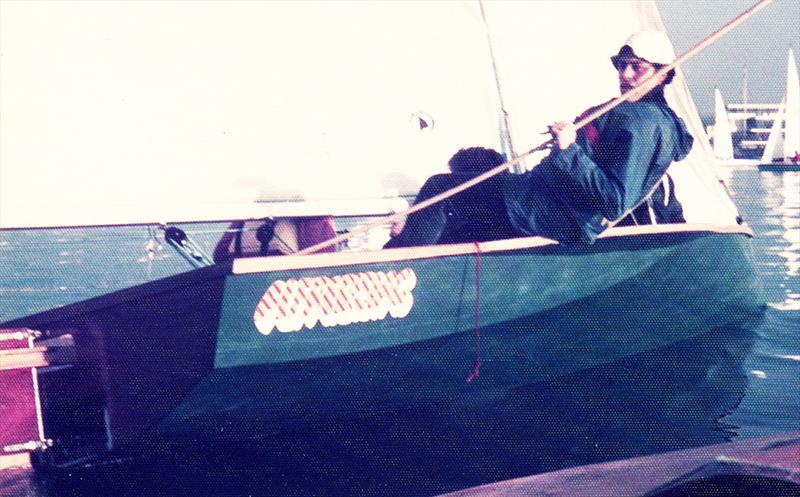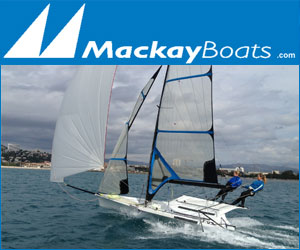
The British 18 Footer Challenge
by Frank Quealey 4 Sep 23:29 PDT
The British challenge to conquer the world of the 18 footers began in 1973 when Alf Reynolds built the first 18 footer in England, which he named Alfrodisiac, but even the pioneering Alf possibly wouldn’t have believed then how successful those following him would be within the next 49 years.
Reynolds’ breakthrough boat immediately created momentum for the challenge and a group of interested sailors soon established a fleet of Bruce Farr-designed skiffs for the 1974 season. The leading skippers in the fleet were Reynolds, Bruce Long and Peter Legrove.
Within the next 2-3 seasons, these skippers extended their 18 footer experience with entries in Giltinan world Championship regattas. Alf Reynolds was the first, when he competed at Brisbane in 1975, before Peter Legrove’s challenge in a chartered skiff at the 1977 championship, on Waitemata Harbour, Auckland, included an all-British team for the first time.
A milestone in the challenge occurred in July 1978 when a group of Australian and New Zealand teams went to Plymouth, England to sail in an Open world Championship regatta (unrelated to the Giltinan world Championship) against teams from the UK and France. The recently-crowned Giltinan champion Color 7 team of Iain Murray, Andrew Buckland and Don Buckley, took the five-race series.
Unfortunately for the British fleet late in the 1970s, the technology leap from the Bruce Farr timber hull, being sailed in the UK, to the Iain Murray-designed carbon fibre-foam constructed hull, was just too much for an emerging fleet to handle and the momentum was lost.
Even the Open Worlds Championship was unable to generate enough interest to cover the increased costs and the on-going rapid development in the class at the time. The situation also had a similar effect on the established fleets in Brisbane and Auckland, which became merely a shadow of their former glories.
Naturally, the British Challenge was hard hit as their boats instantly became obsolete and there was definitely no funding to cover the use of the new technology. At the same time, ‘wings’ were introduced to the class which completely changed the rigs which further accelerated the need for continual change, even during each season.
Needless to say, the British Challenge at the Giltinan Championship, which had looked so promising during the 1970s, stalled during the 1980s. New Zealand, Brisbane and USA suffered a similar fate.
Not even the two Sydney fleets were immune from the difficulties associated with the cost of competition. Only the top half of the fleet could cope with the annual budget to be competitive and their fleets declined through the 1980s to a point which required new rules to stop the problem.
The first light at the end of the tunnel for a resurgence in local numbers, and a more even playing field for international competition, came after Julian Bethwaite introduced his B18 design in the late 1980s.
Julian’s concept met with almost immediate success and his AAMI skiffs won the 1991 and 1992 Giltinan Championships as well as the TV Grand Prix Sailing series in 1991 and 1993.
Only when the Australian 18 Footers League introduced a new Iain Murray design, in 1993, as the single design accepted for competition at future Giltinan World Championships, did the international scene explode and allow for the possibility of future champions coming from never-before winning countries.
A more level playing field, together with the ability to build its own hulls from a mould produced by the League, enabled Britain to resume its challenged that had been dormant for nearly fifteen years.
The Brit challenge was actually ‘reborn’ at the JJ Giltinan world Championship when seven UK entries (six from England and one from Scotland), led by the designated UK 18 footer boat builder David Ovington, contested the 1995 regatta on Sydney Harbour, then another team, led by Tim Robinson, competed at the following regatta in 1996.
In 1997, only one team made the trip south to Australia but three teams (Simon Nearn, Tim Robinson and Rob Dulson) were present when a second Giltinan Championship regatta that year was sailed in Europe for the one and only time.
The British Challenge reached its original target, twenty six years after Alf Reynolds’ first 18 footer in 1973, when the Tim Robinson-led Rockport team of David Witt and Zeb Elliott won the JJ Giltinan world 18 footer Championship on Sydney Harbour in 1999.
Tim recalls: “In my earlier attempts to race the JJ Giltinan my team had come down in our Ovy one designs and always felt inferior equipment wise, so when the League decided to sell off a few of their boats, we saw this as a great opportunity to try and compete on level terms.”
“I bought the old Tyrells Wines in 1998, which had a reputation for being very fast, and set about planning for the 1999 JJ. I asked David Witt to join the team, when he came to the UK to sail part of the UK 18 Footer Series. He was quite forceful, regarding our sail program and we bought a new set of sails from Ian Short, in Sydney.”
“Of course, being Witty, we ended up with the biggest sails it was possible to build. They were very big and very flat, which meant we were super-fast in the breeze and really quite slow in the lighter winds. This meant winning the windier races by minutes but struggling in the lighter days.”
“I recall being some way ahead on points going into the last race and needing to finish no lower than 14th to win. The wind was light and we were about 18th and the stress levels were mounting, but we got there in the end.”
Tim followed his 1999 victory with top five finishes at the 2000 and 2001 JJs in an Australian-built skiff, named Great Britain, but it was also becoming obvious to followers that there was another potential British Giltinan champion, Rob Greenhalgh, on the way.
Greenhalgh’s first challenge came in 2001 when he sailed a former Sydney skiff, under the name Fat Face, then had a new hull built by Ovington Boats in preparation for another challenge at the 2002 regatta.
RMW Marine came on board as sponsor and, despite some new boat teething problems, the team performed well and finished in the top group, but Rob’s competitive nature was now committed to winning ‘the big one’.
Rob was back to Sydney Harbour for a crack at the 2003 championship, and going into the final race of the regatta, the very fast and consistent RMW Marine held a lead which appeared would be good enough to take the title.
USA’s Howie Hamlin, the defending champion, was the nearest challenger and had to finish first or second in the race and hope that RMW Marine would finish worse than fifth.
RMW Marine led early in the race and was still fourth at the final rounding mark, and looked to have the championship won, but as the fleet worked across the harbour to the finish line, Greenhalgh’s team was caught on the wrong side of a wind shift and was passed by two other competitors, which relegated the team back to sixth place.
The incredible finish gave the 2003 championship to Howie Hamlin by just 0.35 of a point.
Finally, at the 2004 JJs, following recent victories at Carnac (France) and San Francisco, Greenhalgh’s RMW Marine team dominated the regatta with four wins and one second placing from the first six races and had the championship won with a race to spare.
Rob’s involvement with the ABN AMRO team’s challenge for the 2005-06 Volvo Ocean Race took most of his time over the following year and the RMW Marine team hadn’t sailed an 18 since the 2004 victory.
Despite the lack of practice, RMW Marine was the only team to win more than one race at the 2005 championship but wasn’t consistent enough and finished in third place, just two points behind the winner, Euan McNicol’s Club Marine.
Things went quiet for the Brits after 2005 and only one skipper, Jarrod Simpson, represented the UK in the next three Giltinan Championship contests, but all that changed in 2009 when two basically British teams finished in the top seven placings at the JJs.
It was an unusual set of circumstances. The second placed Active Air-2UE team included two Brits Matthew Searle and Archie Massey with local Dan Wilsdon but was representing Australia. The second team was Project Racing, which finished seventh in the championship.
Project Racing was owned and skippered by British Andy Budgen and had a full team of British sailors. It was a full UK representative at the championship but had spent the entire Australian summer season in the Australian 18 Footers league fleet as part of the build-up for the championship challenge.
Rob Greenhalgh had a new 18, named Benny, built in 2008 and won the inaugural Mark Foy Trophy regatta at the Yacht Club de Carnac in June 2009. He had no plan to return to Sydney for the 2010 JJs, but when shipping support from PSP Worldwide Logistics and Aust-Asia Worldwide Shipping came about, the team made a last-minute decision and finished seventh in the regatta.
In the regattas between 2010 and 2014, there was strong UK representation in both UK and local Australian boats by Andy Budgen, Jarrod Simpson, Archie Massey, Nick Murray and James Mears.
Jarrod Simpson continued to challenge regularly until 2019 before the British Challenge went silent.
While the UK entries at the past few Giltinan Championships has been lower than normal, the British influence in 18 footers at the League is still very strong.
Ed Powys has been a regular sheet hand on Sean Langman’s Noakesailing team since 2019, and Simon Nearn, who was a member of the UK fleet during the 1990s, before moving to Australia and joining the club’s fleet on Sydney Harbour.
Simon became skipper of De’Longhi in 2008 and has since become a member of the club’s Board of Directors, and is presently Commodore of the Australian 18 Footers League.




